Purpose The aim of this study was to examine how middles school students in physical education class perceived relations between parental and teacher’s autonomy support, enjoyment, self-efficacy, academic effort, and P · E class flow. This study also investigate the mediating effects of enjoyment, self-efficacy, and academic effort on the relations between parental autonomy support and P · E class flow and between teacher’s autonomy support and P · E class flow. Methods For this study, 323 middle school students completed surveys to measure their perceptions of parental and teacher’s autonomy support, enjoyment, self-efficacy, academic effort, and P · E class flow. SPSS 24.0 was used to calculate descriptive statistics, reliability, and correlations. Amos 22.0 was utilized for confirmatory factor analysis, convergent validity, discriminant validity, and structural equation modeling. Additionally, 2000 bootstrap samples were requested for the mediation effect analysis. Results First, parental autonomy support was positively predictive of enjoyment and self-efficacy. Second, teacher’s autonomy support positively influenced enjoyment and self-efficacy. Third, enjoyment and self-efficacy positively affected academic effort. Forth, academic effort was positively related to P · E class flow. Fifth, there were partial mediating effects of enjoyment, self-efficacy, and academic effort on the relationship between parental autonomy support and P · E class flow. Lastly, there were partial mediating effects of enjoyment, self-efficacy, and academic effort on the relationship between teacher’s autonomy support and P · E class flow. Conclusions The study found that teachers' autonomy support was stronger predictive of student’s P · E class flow in physical education class than parent's autonomy support was. The finding is meaningful in that it is worth providing and utilizing practical knowledge from an educational perspective.
PURPOSE This study analyzed the relationship among coaching behaviors, motivational climate, sports competence, effort, and failure tolerance as perceived by high school athletes. Additionally, it examined whether motivational climate, competence, and effort mediate the relationship between coaching behaviors and failure tolerance. METHODS Using questionnaires measuring autonomy-supportive coaching behavior, controlling coaching behavior, motivational climate, sports competence, effort, and failure tolerance, 365 high school athletes were surveyed. Using SPSS 28.0 and Amos 28.0 software, descriptive statistics and structural equation modeling were conducted along with the following types of analyses: reliability, correlation, confirmatory factor, convergent validity, and discriminant. Additionally, the bootstrap method was used to verify serial multiple mediating effects. RESULTS Autonomy-supportive behavior had a significant positive effect 1) on motivational climate, sports competence, and effort and 2) on failure tolerance. 3) Controlling coaching behavior had a significant negative effect on motivational climate and sports competence. 4) Motivational climate and 5) sports competence both had a significant positive effect on effort. 6) Effort had a significant positive effect on failure tolerance. Last, in the relationship between autonomy-supportive behavior and failure tolerance, motivational climate, sports competence, and effort showed partial mediating effects. CONCLUSIONS This study confirms the importance of coaches’ autonomy-supportive behavior in determining failure tolerance among adolescent athletes. Based on this information, counseling (educational) programs aimed at enhancing performance can be developed and provided in sports settings, thus fostering success among athletes.

Purpose This study was to explore construct of fear and courage behavior overcoming the fear and relationship between fear and courage in competition. Methods Total 65 national athletes of combat sports(Judo, Boxing, Taekwondo, Fencing) responded to open questionnaire about fear and courage behavior in competition. The data was analyzed by triangle verification and content analysis. Results Firstly, the fear of combat sports athletes consisted of five factors, which were negative consequences, lack of preparation for a game, concerns of performing one’s best, expectation of significant others, and internalized ego threat. Secondly, courage behaviors to overcome fear were self-effort, self-suggestion, self-conviction, selfish self-regulation, social self-control, self-analysis, and acceptance of experience. Finally, there were the relationship between fear and courage in competition. Conclusion These results will contribute to provide useful information for combat sport athletes and coaches in different level to cope with competition fear.

PURPOSE This study aimed to explore the structural relationships between technology-related factors and the intention to use baseball data, drawing upon the Unified Theory of Acceptance and Use of Technology (UTAUT) and technology readiness (TR). METHODS Survey data from 203 Korean professional baseball players were used in frequency, reliability, correlation, and confirmatory factor analyses as well as structural equation modeling. RESULTS Positive TR positively influenced performance expectancy, effort expectancy, social influence, and conditions facilitating baseball data use. Negative TR did not significantly impact performance expectancy, effort expectancy, social influence, and conditions facilitating baseball data use. Performance expectancy, effort expectancy, and facilitating conditions were found to positively influence data use intention, while social influence did not significantly impact data use intention. CONCLUSIONS The findings suggest that increasing performance expectancy, effort expectancy, and facilitating condition factors could be key to enhancing the intention to utilize baseball data.
PURPOSE The purpose of this study was to analyze the effect size of the unified theory of acceptance and use of technology (UTAUT) in the sports field using a meta-analysis. METHODS After identifying related studies by using RISS, 22 articles were selected and used to analyze the relationship between UTAUT sub-factors (performance expectancy [PE], effort expectancy [EE], social influence [SI], and facilitating conditions [FC]) and intention to use via the comprehensive meta-analysis program. RESULTS The results are as follows: First, the effect size between PE and intention to use was 0.521. Second, the effect size between FC and intention to use was 0.514. Third, the effect size between EE and intention to use was 0.500. Finally, the effect size between SI and intention to use was 0.475. CONCLUSIONS Diverse strategies can be derived to increase consumers' intention to use in the sports field using the UTAUT model.
The recent increases in international efforts for designing and implementing initiatives and programs about 'development though sport' have accompanied the remarkable growth of the 'sport for development and peace'(SDP) sector. This global prevalence of SDP and the resulting augmentation of its social significance have rendered a growing scholarly attention to SDP in the sociology of sport. Moreover, a grounding rationale for SDP initiatives to enhance positive individual and social changes through sport has also offered an interesting research area for the sociology of sport. This paper aims to review sport sociology literature about SDP. Major findings include a set of descriptive reports about the institutionalization of SDP and critical/reflective approaches to SDP's outcomes and limitations. It is noted that the institutionalization of SDP consists of ideological and policy endeavors, SDP organizations and institutions, and classifications of SDP project types. Despite of positive outcomes resulted from SDP programs, it has been highlighted that the ongoing issues and limitations of SDP include ambiguities of development concept, the Global North hegemony, unilateral top-down program management, and the inherent complexity and lack of program monitoring/evaluation.

Purpose This study attempted to investigate the difference on job satisfaction and service quality between non-regular and regular workers in commercial sports facilities. Methods With the purpose of the study, the purposive sampling as the non-probability sampling method was used to intentionally select the representative cases. We conducted through utilizing in-depth interviews with 6 non-regular and regular workers, respectively, who have worked for more than a year at total commercial sports facilities holding more than 3 programs with more than 500 memberships. This study aimed to explain real phenomena as much as possible by utilizing NVivo 11, one of qualitative research method programs, on the basis of raw data. Results In conclusion, non-regular and regular employment types in commercial sports facilities did not affect service quality provided for customers. However, it was derived that there was a slight difference between regular and non-regular workers on job satisfaction. Conclusion It is necessary to improve the wage and compensation system for regular workers as well as the labor policy to improve treatment of the wage according to the qualification of non-regular workers in commercial sports facilities. In spite of the instability of non-regular workers, the effort of converting into regular workers would evoke organizational commitment, loyalty, and attachment of non-regular workers, when properly acknowledged.






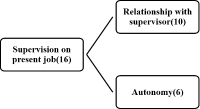










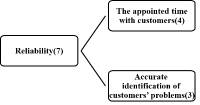





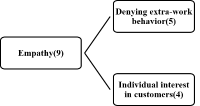
This study conducted to explore K-League (Korea Professional Football League) referees’ psychological experience and coping strategies just after the moment of wrong judgment. Open-ended questionnaire were conducted on 35 full-time referees who participated in the K-League winter training camp. The data were categorized by inductive content analysis. The results were as follows. Psychological experience yielded 45 raw data points, which were based on the following 10 sub categories; increased anxiety, rumination wrong judgment, concern about reprimand, and feeling apologetic; and four general categories including, psychological fragmentation, feeling helpless, concern about reputation, and acknowledgment of wrong judgment. Thus, K-league referees experience a psychological turbulence just after the moment of the bad calls and worsen feelings of helplessness about the wrong decisions. Also, K-league referees worry about further disadvantages following the misjudgement and admit their bad calls feeling sorry for teams and athletes who were in the incidents. Coping strategies yielded 55 raw data points from which the following categories were identified 11 sub categories; increasing concentration, attempting to forget wrong judgment, apologizing on wrong judgment, and change in thinking; and four general categories including, emotional self-support, avoiding situation, correcting the error and thinking, and changing of refereeing approach. Therefore, K-league referees enhance their concentration in order to not reoccur wrong judgement after the moment of the mistakes and try to forget the incidents of wrong judgement. Also, K-league referees apology to the teams and athletes who experienced the bad calls and make efforts to correct the mistakes if possible. Moreover, K-league referees try to modify a criteria of judgement in order to manage aftereffects of wrong judgement and make decisions correctly by approaching the scenes of the wrong judgement. The study emphasizes the importance of referee psychological stability on the field and the need for psychological support. The study is expected to encourage further research on sports referees in Korea to ensure they receive appropriate psychological support.

The purpose of this study was to evaluate sports commentators’ public confidence by the difference between media recipients’ expected level on the public confidence and their perceived outcomes, and to investigate how such characteristics are perceived by media recipients. The questionnaires were given out to people in Seoul and Gyeonggi province, who have experience of having watched the 2014 FIFA World Cup Brazil. The samples were collected by snowball sampling method and a total of 218 questionnaires were chosen as final validity sample. For data analysis, frequency analysis, exploratory factor analysis, paired t-test, importance-performance analysis (IPA), PROXSCAL analysis, and a multiple regression analysis were done by using PASW 21.0. The derived results are as follows: First, according to results from IPA analysis, the Quadrant I is a status-quo area, which is inclusive of the professionalism of KBS and SBS commentators. The Quadrant Ⅱ is a concentrated effort-oriented area, which includes dynamics of KBS and SBS commentators, and professionalism and dynamics of MBS commentators. The Quadrant Ⅲ is an inferiority ranking area, which contains popularity of KBS and SBS commentators, and reliability of MBC commentators. The Quadrant Ⅳ is a rejection of overexertion area, which incorporates reliability of KBS and SBS commentators and popularity of MBC commentators. Second, according to results from MDS analysis in terms of the characteristics of public confidence, an order of KBS>SBS>MBC appeared in the fields of professionalism, reliability and dynamics, and an order of KBS>MBC>SBS appeared in popularity.


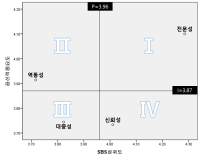
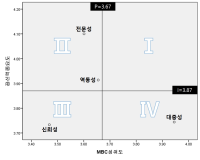
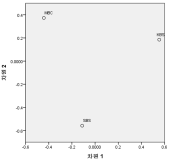
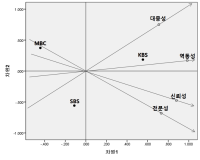
PURPOSE This study aimed (1) to analyze the behavioral intention and use behavior among the consumers of online home training contents via YouTube by employing the unified theory of acceptance and use of technology (UTAUT); (2) to test the moderating effects of risk perception toward the coronavirus (COVID-19) infection, and 3) to test differential impacts of generational difference across millennial and baby boom generations. METHODS A total of 400 questionnaires were distributed, and 383 samples were used for the final analysis after excluding 17 incomplete responses. Data were analyzed using the SPSS 25.0 and AMOS 22.0. RESULTS It was found that (1) the performance expectancy, the effort expectancy, and the social influence had positive effects on behavioral intention; (2)the facilitating condition had negative effects on the use behavior; (3) the behavioral intention had positive impact on the use behavior. Moreover, the risk perception toward the COVID-19 infection did not have moderating impacts on the UTAUT model, whereas generational differences did. CONCLUSIONS Our results suggest that the marketing strategy that improves exercise performance, convenience, and social influencing factors may be key to home training customers' behavioral intention and use behavior. Furthermore, home training material makers should recognize that the features and infrastructure required for the two generations are distinct and develop a separate marketing strategy for each.